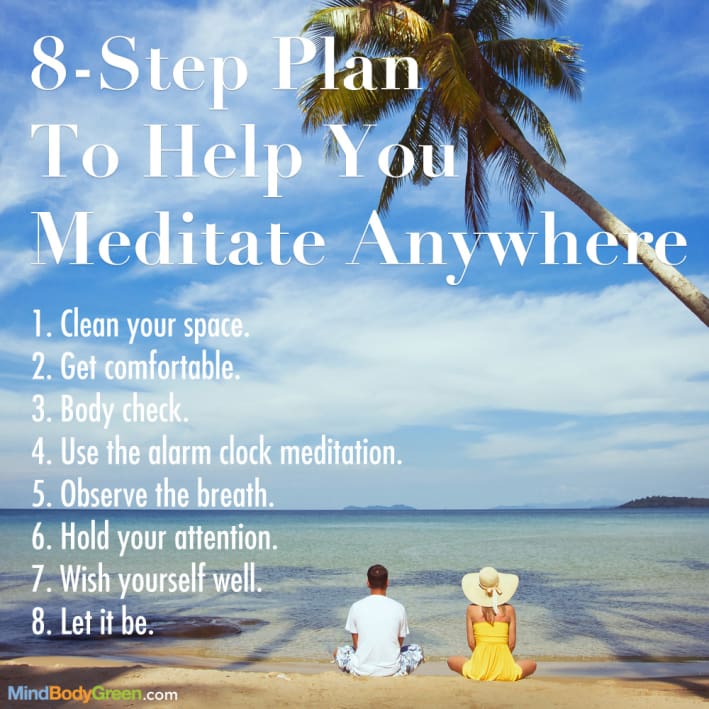HOW TO PRACTICE MINDFULNESS IN YOUR WORKOUT ROUTINE
When we’re trying to get the best from our bodies, how we move through the world is crucial.
Take control of that spinning top you set in motion every day when you wake – the mind – and see significant improvements in your exercise output and results. With routines that maintain presence and grace in every moment, your capability and endurance for exercise will increase as well.
1) STAY PRESENT AND STAY ON TARGET
Want to know the mental trick successful mountaineers use to climb the Mt. Everest? To perform arguably the most physically demanding, grueling endeavor of human achievement?
It’s simple: put one foot in front of the other. The trekkers meditate upon the next step. And only the next step.
Because. Anything. Else. Is. A. Distraction. From. The. Goal.
Easier said than done when you’re lungs are screaming from lack of oxygen and every muscle cries out in protest at the almost impossible struggle they’re enduring. There’s always the voice in the back of the head reminding them that physical injury, total failure and death are permanent possibilities.
While we might not summit the highest of peaks, fending off unpleasant and unhelpful thoughts and emotions while working out is no less important for us.
Distractions at the gym – be it sweat in the eyes, burn in the muscles, ache in the lungs, a cute guy or girl nearby, or feelings of inadequacy – all pull us away from our goal-oriented activities.
If the focus goes, so might your resolve to finish (or start) the workout.
Treat your distractions as scenery and let them pass you by from one moment to the next. Emotions only last for 90 seconds before disappearing, say recent scientific research. Outlast your mind and stay the course.
Where the mind goes, the body follows.
First you need to appreciate the power of right now and the power of the single step. There’s no other way to get to the top of Everest. Or to the end of the workout.
2) PRACTICE A MOVING MEDITATION
When you think of a conscious, mindful athlete you might not think of Arnold Schwarzenegger. But Arnold himself attributed much of his outstanding success as a bodybuilder to what he called “the mind-muscle connection.”
The link was to imagine the internal processes of his musculature in the moment to thereby predict their future growth.
Vividly focusing upon the muscles he was training and visualizing their expansive progress, Schwarzenegger was able to push himself harder than anyone else. Because he grounded every set within the bedrock that was his determination, he was able to max-out reps and sets long after his contemporaries threw in the towel. The result is the renowned legacy of his Olympian physique.
You can use the same techniques and make your workout a moving meditation.
Shift your focus inside yourself, away from the external resistances of the weights you may be lifting or the pavement you may be pounding.
Feel the energetic dimensions that your muscles move within. The source of your power (and change) is the energy within the body. Connect your mind to the muscles, following their movements in a fluid way. Guide the muscles when it’s time for that extra push – and observe your enhanced capabilities.
Focus upon the energy required to complete each action. With a mind-body connection, you’re primed for a maximum-output workout because you’re connected more with your energy sources.
Getting “in the zone” like this is known as a flow state. This is an intensely powerful condition when mind and body seem to function in perfect harmony, where mindful effort seamlessly moves into reality in real-time.
Make your workout a moving meditation and focus inward to achieve the satisfying feelings of the flow state and it’s incredible results.
3) SET YOUR INTENTION
Before you begin to exercise, take a moment to review your purpose for being in the gym, out for a run, or wherever your physical routine might take. Remind yourself of where you left off last time, what you’re trying to accomplish today and the long-term goals that brought you there.
Are you trying to increase your squat reps from 135 to 155? Do you need to remember to stretch after your workout? Should you take it easy on the bench today because your shoulder is giving you pain? (Yes).
A great time to do a mental check is when you’re limbering up, doing some dynamic range of motion moves to get the blood pumping in the body.
The action is the same for the mind. Invigorate your sense of purpose by mentally preparing for action.
You’ll be able to complete your goal better with a vision of success.
Our bodies and minds work best in concert with another, so take your workout to the next level by organizing your mental zone before getting physical.
4) ENERGIZE WITH BREATH
Say what you like about protein, but the body’s energy supply while exercising is the breath.
When the breath stops coming in regular intervals, life becomes needlessly difficult. An appropriate breathing cadence within your exercise programs is essential to keeping your energy levels high.
Many of us have developed physical habits and mindsets surrounding our workouts that obstruct our fitness goals. And only by fixing these issues can we accomplish the workouts we want.
For example, my current challenge is keeping my breathing steady during cardio. If I don’t consciously correct how I breathe, I fall back into a nearly hyperventilated pattern after a short time. When this happens, running a three mile warmup turns from a cardio session into a gruelling sweat-fest of pain.
I don’t know how I got to this point but I know how to fix it: slow and steady breathe circulating deep into my lower abdomen, inhaling and exhaling through the nose. The image I use to keep pace is a cup being slowly filled and drained of water.
As I’m kicking my legs and doing a few dips before stepping on the treadmill, I remind myself to start my run slowly and allow myself to breathe easily.
And it works wonders. I’m able to run harder for longer and with greater enjoyment. Thanks to a mindful technique, all it takes is 15 seconds before starting off to secure increased performance.
5) FEEL YOUR BODY
It’s easy to take the body for granted. We live inside it every day and only pay it mind when something starts to hurt or seems out of place. This is normal because our body is a relative system; if it wasn’t, we’d go crazy from the over-stimulation.
Being aware of body sensations that arise is a great way to stay mindful. Being conscious of your energy level, aches and pains and overall physical condition provides a gauge for your current status and protects your body from injury.
And let’s you know when to ramp up the intensity.
Start by closing your eyes. Take an inventory of the feelings in your extremities, from your head to your toes. How does your stomach feel? What’s your breathing like?
Most of us only become aware of these factors after we’ve been exercising for a bit. But you can reach that heightened state from the beginning of your workout for higher quality workouts every time.
Being well attuned to the body improves form while exercising, aligns movements with breath and increases spatial awareness. Attend to your body in this way and you’ll see how quickly you feel connected to your physical form.
Try this technique for getting motivated to go to the gym.
LAST THOUGHTS
These have been five mindful practices you can use to improve the quality of your workouts. By using meditative techniques, a potent mind and body connection is realized and can be enjoyed both in and out of the gym. Staying present with the body is first a matter of conscious breathing and sensing the body. The mind is a powerful tool as well, best used with a clear sense of purpose and a vision of what’s to come. The combination is more than the sum of the parts, so practice exercises with meditative techniques to reach a new state of achievement and satisfaction with your workouts.
https://blog.fitplanapp.com/mindful-fitness/









